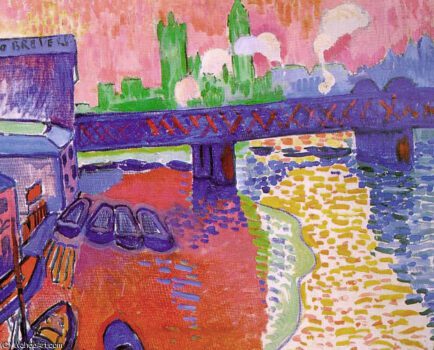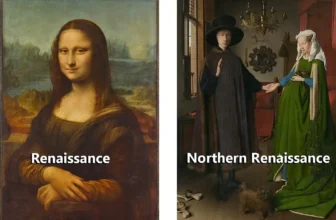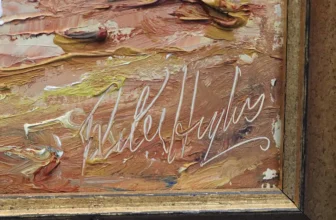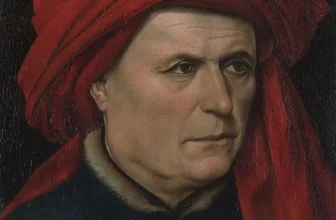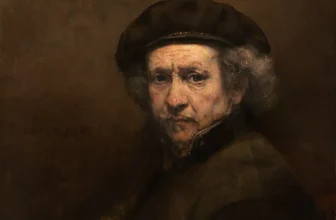Meaning of “Charing Cross Bridge” by André Derain
In the pantheon of early 20th-century avant-garde painting, André Derain’s “Charing Cross Bridge” stands as a dazzling display of color, abstraction, and emotional expression. Painted during a transformative period in art history, this work not only captures a specific place and moment in time but also heralds a new artistic vision, one that breaks from tradition and reflects the inner energy of the modern world.
In this in-depth analysis, we explore the story behind the painting, its creation, stylistic characteristics, symbolism, and its continuing significance in the art world today.
Who Was André Derain?
To understand “Charing Cross Bridge, London,” one must first understand André Derain, a pivotal figure in the birth of Fauvism, the first avant-garde movement of the 20th century. Born in 1880 in Chatou, France, Derain was a painter, sculptor, and co-founder of Fauvism alongside Henri Matisse. Known for his bold use of color and simplified forms, Derain challenged the naturalism that dominated 19th-century painting.
By the early 1900s, Derain was emerging as a dynamic force in the Parisian art scene. His friendship with fellow painter Maurice de Vlaminck and his association with Matisse helped shape his radical ideas about color and form. Derain believed that color was not just a tool to describe the visual world, it was a vehicle of emotion and imagination.
The Origin and Context of “Charing Cross Bridge, London”
Commission and Travel to London
In 1905, Derain’s dealer and patron, Ambroise Vollard, commissioned him to travel to London to paint the city’s iconic landmarks. The idea was not original, Claude Monet had painted the Charing Cross Bridge, Houses of Parliament, and Waterloo Bridge just a few years earlier. However, Vollard wanted something different, he wanted Derain to interpret the city with the new visual language of Fauvism.
Derain accepted and traveled to London in 1906, where he spent several months creating a series of over 30 paintings. “Charing Cross Bridge, London” is among the most celebrated from this group.
What is the Painting About?
At first glance, “Charing Cross Bridge, London” appears to be a familiar scene: the famous bridge spanning the River Thames with the London skyline in the background. Yet, this is no ordinary depiction of London. It is a visionary reimagining of a city seen through the lens of color, light, and energy.
The bridge itself is portrayed in simplified, almost schematic forms. The river glows with vibrant, unnatural hues, pinks, oranges, and greens that ripple across the canvas. Boats float dreamily along the Thames, and the skyline, including the hazy silhouette of Westminster, appears abstracted and misty, as though melting into the atmosphere.
But Derain’s work is not an exercise in documentation. It is an emotional and sensory interpretation of London’s essence. He once said that he was more interested in “translating” a scene than reproducing it, and this painting exemplifies that philosophy.
How Was “Charing Cross Bridge, London” Painted?
Derain employed pure, non-naturalistic colors, laying them in bold, flat patches across the canvas. This technique, derived from Post-Impressionism and pointillism (particularly Seurat), was transformed by Derain into a more aggressive, expressive style.
The brushwork is brisk and visible, yet the composition remains harmonious. He likely worked from sketches and painted in his studio, synthesizing the raw visual input of London with his artistic imagination.
His approach was intuitive rather than analytical. The work does not strive for precision or realism; instead, it seeks to evoke the feeling of the place, its rhythm, its air, its noise, and its fog. This makes “Charing Cross Bridge, London” not just a visual experience but an immersive emotional encounter.
What Kind of Art Is It?
“Charing Cross Bridge, London” is a Fauvist painting. Fauvism (from the French “les fauves”, meaning “the wild beasts”) was a short-lived but deeply influential movement that emerged in 1905. It emphasized vibrant color, simplified form, and expressive freedom.
Key characteristics of Fauvism evident in Derain’s painting include:
Arbitrary color: Derain did not attempt to depict naturalistic colors. The Thames is pink, the sky can be lime green, and the buildings glow orange or turquoise. These colors are meant to stimulate emotion rather than describe reality.
Bold brushwork: His paint is laid thickly and confidently, with visible marks.
Simplified shapes: Forms are reduced to their essential outlines, which enhances the abstract quality.
Expressive mood: The painting communicates a mood, perhaps wonder, excitement, or the vibrancy of urban life.
Fauvism was short-lived (roughly 1905–1908), but its emphasis on subjective experience and color as an autonomous element opened the door for later modernist movements, including Expressionism and Cubism.
Symbolism and Deeper Meaning
While Derain did not explicitly use symbols in the traditional allegorical sense, his use of color and form carries symbolic weight. Here are some interpretive insights into the symbolism and meaning of “Charing Cross Bridge, London”:
1. Color as Emotion
The most dominant symbolic element is color. In Fauvism, color conveys feeling and sensation. Derain’s use of clashing, unexpected colors suggests a world vibrating with life and energy. The pink river might evoke warmth or even industrial pollution; the orange skies could suggest the haze of a smog-filled metropolis or the glow of sunset.
2. The Bridge as a Metaphor
Bridges have long been symbolic in art and literature. Here, the Charing Cross Bridge may symbolize connection, between the old and the new, tradition and modernity, or even between the artist and the viewer. It’s a space of transition, of passage, and in Derain’s rendering, it’s suspended in a dream-like world.
3. Urban Modernity
The boats, buildings, and smoky background all hint at the bustling, industrial city that London was becoming. This work can be seen as a celebration of urban energy, a place of constant motion, change, and growth. Derain’s London is not gray and dour, but pulsing with light and vitality.
4. Light and Atmosphere
Derain shows his fascination with atmospheric effects, but unlike Monet, who sought to dissolve forms in light, Derain reimagines light itself as a force of transformation, bending the world into surreal, ecstatic colors.
What Is Happening in the Painting?
On a literal level, the painting captures a typical scene on the River Thames: boats glide on the water, and the bridge serves as a central architectural axis. Yet everything is suffused with color and abstraction, making it feel almost like a dreamscape.
There’s no narrative in the traditional sense, no visible people, no dramatic action. But the scene is dynamic: the motion of boats, the reflection of light, and the swirling colors all give the impression that the city is alive and breathing.
We might imagine that Derain, standing on the embankment, saw not a still scene but a living rhythm, a city beating like a heart, resonating with the pulse of the 20th century.
Comparison to Monet’s Charing Cross Bridge
It’s impossible to discuss Derain’s work without mentioning Claude Monet, who painted Charing Cross Bridge dozens of times between 1899 and 1904. Monet’s version is misty, ethereal, and impressionistic. He was interested in capturing light, fog, and the atmospheric conditions of London.
Derain, in contrast, brought fire and intensity to the same subject. Where Monet dissolved form into mist, Derain used color to sharpen and energize the landscape. Both are interested in perception, but Derain’s is interior, emotional, and explosive.
In this way, Derain takes the Impressionist foundation and pushes it into the realm of modernism, setting the stage for the dramatic visual revolutions of the 20th century.
Where Is the Painting Located Today?
One of the most recognized versions of Derain’s “Charing Cross Bridge, London” is currently held in the National Gallery of Art in Washington, D.C., USA. The painting is part of their permanent collection and is often featured in exhibitions related to early modernism or the development of Fauvism.
Other paintings from Derain’s London series are located in major institutions, including:
The Tate Gallery (London)
The Museum of Modern Art (MoMA) (New York)
Centre Pompidou (Paris)
These paintings, while similar in subject, vary widely in palette and perspective, showing Derain’s commitment to exploring different moods and visual harmonies.
Influence
“Charing Cross Bridge, London” remains one of André Derain’s most iconic and important works. It represents a turning point in Western art, a moment when artists stopped trying to reproduce the world as it looked and began to express how it felt.
Derain’s use of color would go on to influence:
German Expressionists, such as Ernst Ludwig Kirchner and Emil Nolde
Abstract painters like Kandinsky
Color-field painters of the mid-20th century
Although Derain later turned toward more classical styles, his London series remains a testament to his bold, youthful experimentation, a burst of wild color and freedom that helped define modern art.
André Derain’s “Charing Cross Bridge, London” is far more than a cityscape, it is a revolution in paint. It symbolizes a break from tradition and a movement toward personal expression, emotional depth, and visual innovation. In its audacious color, abstracted form, and lyrical energy, it captures both a city and a moment of radical change.
Derain didn’t just paint what he saw, he painted what he felt, transforming London’s gray skies and riverbanks into a symphony of color. In doing so, he not only redefined a place but redefined what art could be.
Even over a century later, the painting vibrates with life, urging us to see the world not as it is, but as it might be, in the wild, vivid light of imagination. image/arthistoryproject.com
